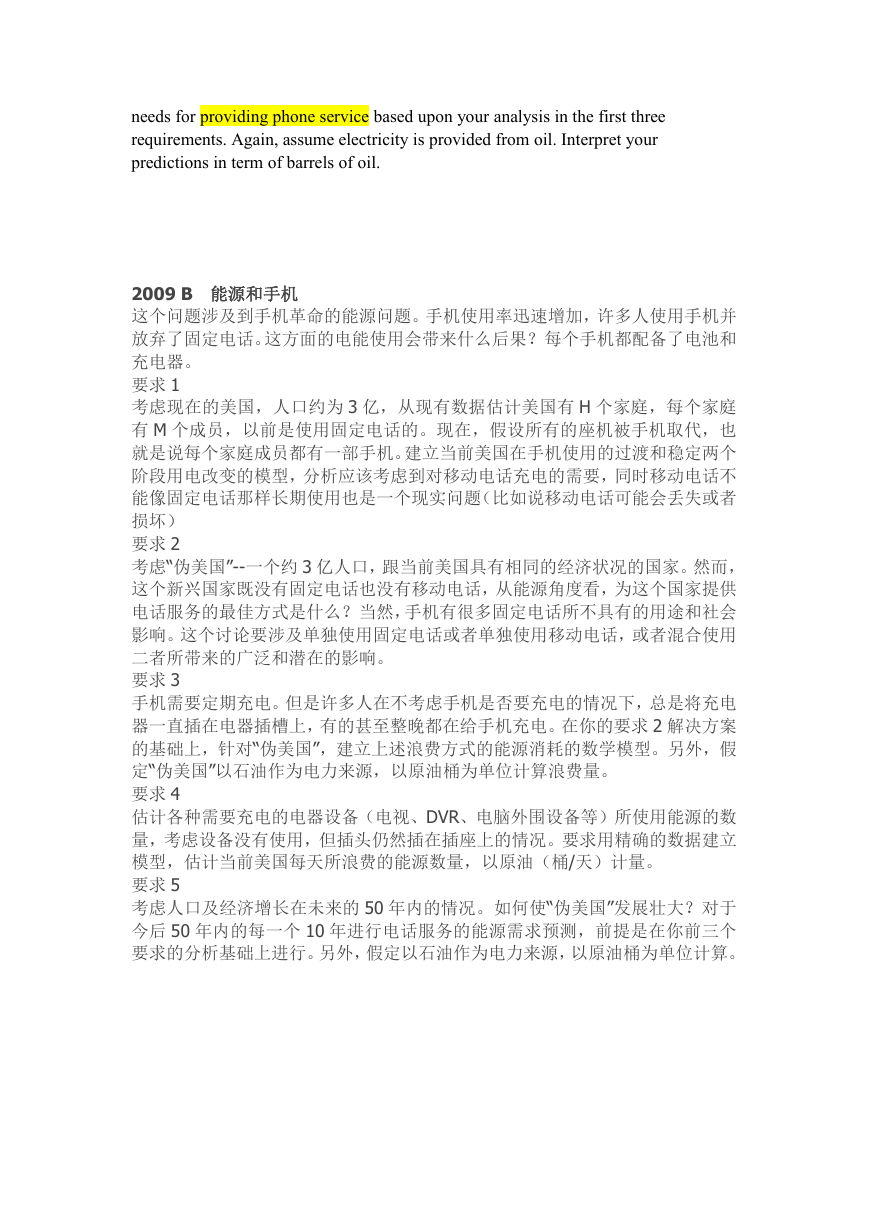2009 B: Energy and the Cell Phone
This question involves the “energy” consequences of the cell phone revolution. Cell
phone usage is mushrooming, and many people are using cell phones and giving up
their landline telephones. What is the consequence of this in terms of electricity use?
Every cell phone comes with a battery and a recharger.
Requirement 1
Consider the current US, a country of about 300 million people. Estimate from
available data the number H of households, with m members each, that in the past
were serviced by landlines. Now, suppose that all the landlines are replaced by cell
phones; that is, each of the m members of the household has a cell phone. Model the
consequences of this change for electricity utilization in the current US, both during
the transition and during the steady state. The analysis should take into account the
need for charging the batteries of the cell phones, as well as the fact that cell phones
do not last as long as landline phones (for example, the cell phones get lost and
break).
Requirement 2
Consider a second “Pseudo US”—a country of about 300 million people with about
the same economic status as the current US. However, this emerging country has
neither landlines nor cell phones. What is the optimal way of providing phone service
to this country from an energy perspective? Of course, cell phones have many social
consequences and uses that landline phones do not allow. A discussion of the broad
and hidden consequences of having only landlines, only cell phones, or a mixture of
the two is welcomed.
Requirement 3
Cell phones periodically need to be recharged. However, many people always keep
their recharger plugged in. Additionally, many people charge their phones every night,
whether they need to be recharged or not. Model the energy costs of this wasteful
practice for a Pseudo US based upon your answer to Requirement 2. Assume that the
Pseudo US supplies electricity from oil. Interpret your results in terms of barrels of
oil.
Requirement 4
Estimates vary on the amount of energy that is used by various recharger types (TV,
DVR, computer peripherals, and so forth) when left plugged in but not charging the
device. Use accurate data to model the energy wasted by the current US in terms of
barrels of oil per day.
Requirement 5
Now consider population and economic growth over the next 50 years. How might a
typical Pseudo US grow? For each 10 years for the next 50 years, predict the energy
�
needs for providing phone service based upon your analysis in the first three
requirements. Again, assume electricity is provided from oil. Interpret your
predictions in term of barrels of oil.
2009 B 能源和手机
这个问题涉及到手机革命的能源问题。手机使用率迅速增加,许多人使用手机并
放弃了固定电话。这方面的电能使用会带来什么后果?每个手机都配备了电池和
充电器。
要求 1.
考虑现在的美国,人口约为 3 亿,从现有数据估计美国有 H 个家庭,每个家庭
有 M 个成员,以前是使用固定电话的。现在,假设所有的座机被手机取代,也
就是说每个家庭成员都有一部手机。建立当前美国在手机使用的过渡和稳定两个
阶段用电改变的模型,分析应该考虑到对移动电话充电的需要,同时移动电话不
能像固定电话那样长期使用也是一个现实问题(比如说移动电话可能会丢失或者
损坏)
要求 2
考虑“伪美国”--一个约 3 亿人口,跟当前美国具有相同的经济状况的国家。然而,
这个新兴国家既没有固定电话也没有移动电话,从能源角度看,为这个国家提供
电话服务的最佳方式是什么?当然,手机有很多固定电话所不具有的用途和社会
影响。这个讨论要涉及单独使用固定电话或者单独使用移动电话,或者混合使用
二者所带来的广泛和潜在的影响。
要求 3(
手机需要定期充电。但是许多人在不考虑手机是否要充电的情况下,总是将充电
器一直插在电器插槽上,有的甚至整晚都在给手机充电。在你的要求 2 解决方案
的基础上,针对“伪美国”,建立上述浪费方式的能源消耗的数学模型。另外,假
定“伪美国”以石油作为电力来源,以原油桶为单位计算浪费量。
要求 4
估计各种需要充电的电器设备(电视、DVR、电脑外围设备等)所使用能源的数
量,考虑设备没有使用,但插头仍然插在插座上的情况。要求用精确的数据建立
模型,估计当前美国每天所浪费的能源数量,以原油(桶/天)计量。
要求 5
考虑人口及经济增长在未来的 50 年内的情况。如何使“伪美国”发展壮大?对于
今后 50 年内的每一个 10 年进行电话服务的能源需求预测,前提是在你前三个
要求的分析基础上进行。另外,假定以石油作为电力来源,以原油桶为单位计算。
�




 2023年江西萍乡中考道德与法治真题及答案.doc
2023年江西萍乡中考道德与法治真题及答案.doc 2012年重庆南川中考生物真题及答案.doc
2012年重庆南川中考生物真题及答案.doc 2013年江西师范大学地理学综合及文艺理论基础考研真题.doc
2013年江西师范大学地理学综合及文艺理论基础考研真题.doc 2020年四川甘孜小升初语文真题及答案I卷.doc
2020年四川甘孜小升初语文真题及答案I卷.doc 2020年注册岩土工程师专业基础考试真题及答案.doc
2020年注册岩土工程师专业基础考试真题及答案.doc 2023-2024学年福建省厦门市九年级上学期数学月考试题及答案.doc
2023-2024学年福建省厦门市九年级上学期数学月考试题及答案.doc 2021-2022学年辽宁省沈阳市大东区九年级上学期语文期末试题及答案.doc
2021-2022学年辽宁省沈阳市大东区九年级上学期语文期末试题及答案.doc 2022-2023学年北京东城区初三第一学期物理期末试卷及答案.doc
2022-2023学年北京东城区初三第一学期物理期末试卷及答案.doc 2018上半年江西教师资格初中地理学科知识与教学能力真题及答案.doc
2018上半年江西教师资格初中地理学科知识与教学能力真题及答案.doc 2012年河北国家公务员申论考试真题及答案-省级.doc
2012年河北国家公务员申论考试真题及答案-省级.doc 2020-2021学年江苏省扬州市江都区邵樊片九年级上学期数学第一次质量检测试题及答案.doc
2020-2021学年江苏省扬州市江都区邵樊片九年级上学期数学第一次质量检测试题及答案.doc 2022下半年黑龙江教师资格证中学综合素质真题及答案.doc
2022下半年黑龙江教师资格证中学综合素质真题及答案.doc